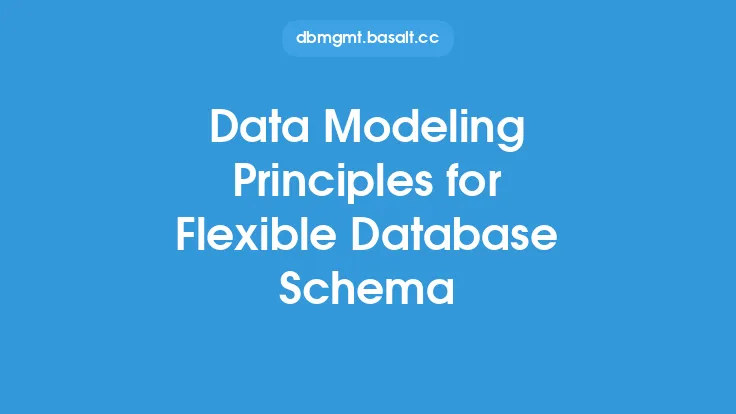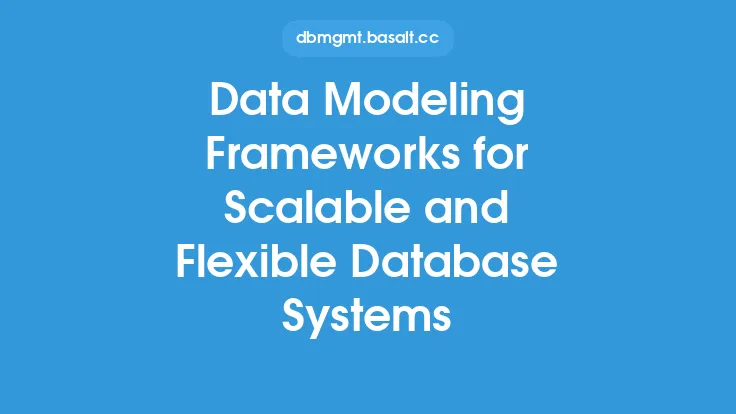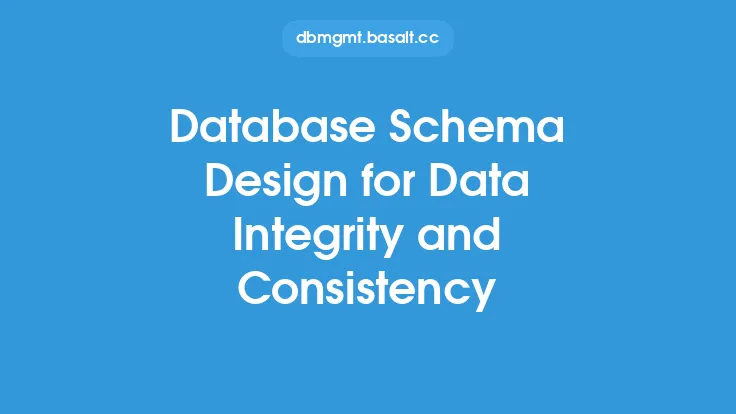Designing a database schema that is flexible and adaptable is crucial in today's fast-paced and ever-changing business environment. A well-designed schema can help organizations respond quickly to new requirements, reduce maintenance costs, and improve overall data management. In this article, we will explore the key principles and techniques for designing a flexible and adaptable database schema.
Introduction to Flexible Database Schema Design
A flexible database schema is one that can evolve and adapt to changing business needs without requiring significant modifications or rework. This is achieved by using design principles and techniques that allow for easy extension, modification, and reuse of existing schema components. A flexible schema is essential for organizations that need to respond quickly to changing market conditions, new regulations, or emerging technologies.
Key Principles of Flexible Database Schema Design
There are several key principles that underlie flexible database schema design. These include:
- Separation of Concerns: This principle involves separating the schema into distinct components or modules, each of which is responsible for a specific aspect of the data model. This allows for easier maintenance and modification of individual components without affecting the entire schema.
- Loose Coupling: Loose coupling refers to the degree to which schema components are independent and self-contained. By minimizing dependencies between components, designers can make changes to one component without affecting others.
- High Cohesion: High cohesion refers to the degree to which schema components are focused on a specific task or function. By ensuring that each component has a clear and well-defined purpose, designers can reduce complexity and improve maintainability.
- Reusability: Reusability involves designing schema components that can be reused in different contexts or applications. This can help reduce development costs and improve consistency across the organization.
Techniques for Flexible Database Schema Design
Several techniques can be used to design a flexible and adaptable database schema. These include:
- Entity-Attribute-Value (EAV) Modeling: EAV modeling involves storing data as a set of entities, attributes, and values. This approach allows for easy extension and modification of the schema, as new attributes and values can be added without modifying the underlying structure.
- Object-Relational Mapping (ORM): ORM involves mapping objects in the application code to tables in the database. This approach allows for flexible and dynamic schema design, as the mapping between objects and tables can be changed or extended as needed.
- Database Views: Database views involve creating virtual tables that are based on the result of a query. This approach allows for flexible and dynamic schema design, as views can be created or modified without affecting the underlying tables.
- Schema Abstraction: Schema abstraction involves creating a layer of abstraction between the application code and the database schema. This approach allows for flexible and dynamic schema design, as changes to the schema can be made without affecting the application code.
Data Modeling for Flexibility
Data modeling is a critical aspect of flexible database schema design. A good data model should be able to capture the complexity and variability of the business data, while also providing a flexible and adaptable structure for the schema. Some key data modeling techniques for flexibility include:
- Using Generic Data Types: Using generic data types, such as strings or integers, can provide flexibility in the schema, as these types can be used to store a wide range of data values.
- Avoiding Overly Complex Data Models: Avoiding overly complex data models can help improve flexibility, as simpler models are easier to understand and modify.
- Using Data Model Abstraction: Using data model abstraction, such as abstract entities or relationships, can provide flexibility in the schema, as these abstractions can be used to capture complex business rules and relationships.
Database Schema Evolution
Database schema evolution involves making changes to the schema over time, while minimizing the impact on existing applications and data. Some key techniques for schema evolution include:
- Using Version Control: Using version control, such as Git or SVN, can help track changes to the schema and provide a clear audit trail.
- Creating a Schema Change Management Process: Creating a schema change management process can help ensure that changes to the schema are properly reviewed, tested, and deployed.
- Using Automated Schema Migration Tools: Using automated schema migration tools, such as Flyway or Liquibase, can help simplify the process of making changes to the schema and reduce the risk of errors.
Best Practices for Flexible Database Schema Design
Several best practices can help ensure that a database schema is flexible and adaptable. These include:
- Keeping the Schema Simple and Focused: Keeping the schema simple and focused can help improve flexibility, as simpler schemas are easier to understand and modify.
- Using Standardized Naming Conventions: Using standardized naming conventions can help improve flexibility, as consistent naming conventions can make it easier to understand and modify the schema.
- Providing Clear Documentation: Providing clear documentation can help improve flexibility, as good documentation can make it easier for developers to understand and modify the schema.
- Testing and Validating the Schema: Testing and validating the schema can help ensure that it is flexible and adaptable, as thorough testing can help identify potential issues and areas for improvement.
Conclusion
Designing a flexible and adaptable database schema is crucial in today's fast-paced and ever-changing business environment. By using key principles and techniques, such as separation of concerns, loose coupling, and high cohesion, designers can create a schema that can evolve and adapt to changing business needs. By following best practices, such as keeping the schema simple and focused, using standardized naming conventions, and providing clear documentation, designers can ensure that the schema is flexible, adaptable, and easy to maintain.





